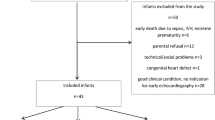Abstract
The pulmonary effects of closure of a patent ductus arteriosus (PDA) were investigated in 11 premature infants with severe respiratory distress syndrome. Successful closure of a PDA did not improve the short-term severity of pulmonary disease (24 and 48 h after treatment) as judged by the arterial/alveolar oxygen tension ratio or the amount of ventilatory support. Also, pulmonary mechanics measured 24 h before, 24 and 48 h after treatment, were not statistically different.
Conclusion
Infants with severe respiratory disease requiring high ventilation pressure and high oxygen concentration, where structural changes in the lungs are already established, will rarely show short-term improvement in pulmonary disease as a result of closure of a PDA. The overall clinical condition may, however, improve as a result of reduced cardiovascular strain. Earlier treatment of a PDA could reduce the ventilation period and the possible risk of developing chronic lung disease.
Similar content being viewed by others
Abbreviations
- PDA :
-
patent ductus arteriosus
- RDS :
-
respiratory distress syndrome
- C L :
-
dynamic lung compliance
References
Clyman RI, Mauray F, Heymann MA, Roman C (1987) Cardiovascular effects of patent ductus arteriosus in preterm lambs with respiratory distress. J Pediatr 111: 579–587
Cotton RB, Stahlman M, Kovar I, Catterton WZ (1987) Medical management of small preterm infants with symptomatic patent ductus arteriosus. J Pediatr 92: 467–473
Gerhardt T, Bancalari E (1980) Lung compliance in newborns with patent ductus arteriosus before and after surgical ligation Biol Neonate 38: 96–105
Greenspan J, Abbasi B, Bhutani VK (1988) Sequential changes in pulmonary mechanics in the very low birth weight (≤1000 grams) infant. J Pediatr 131: 732–736
Heldt GP, Pesonen ET, Merrit TA, Elias W, Sahn DJ (1989) Closure of the ductus arteriosus and mechanics of breathing in preterm infants after surfactant replacement therapy. Pediatr Res 25: 305–321
Hjalmarson O (1981) Epidemiology and classification of acute neonatal respiratory disorders. Acta Pædiatr Scand 70: 773–783
Krauss AN, Fatica N, Lewis BS, Cooper R, Thaler HT (1989) Pulmonary function in preterm infants following treatment with intravenous indomethacin. Am J Dis Child 143: 78–81
Mellander M, Larsson LE (1988) Effects of left-to-right ductus shunting on left ventricular output and cerebral blood flow velocity in 3-day-old preterm infants with and without severe lung disease. J Pediatr 113: 101–109
Stefano JL, Abbasi S, Pearlman SA, Spear ML, Esterly KL, Bhutani VK (1991) Closure of the ductus arteriosus with indomethacin in ventilated neonates with respiratory distress syndrome. Am Rev Respir Dis 143: 236–239
Yeh TF, Thalji A, Luken L, Lilien L, Carr I, Pildes RS (1981) Improved lung compliance following indomethacin therapy in premature infants with persistent ductus arteriosus. Chest 80: 698–700
Author information
Authors and Affiliations
Rights and permissions
About this article
Cite this article
Farstad, T., Bratlid, D. Pulmonary effects of closure of patent ductus arteriosus in premature infants with severe respiratory distress syndrome. Eur J Pediatr 153, 903–905 (1994). https://doi.org/10.1007/BF01954743
Received:
Accepted:
Issue Date:
DOI: https://doi.org/10.1007/BF01954743




